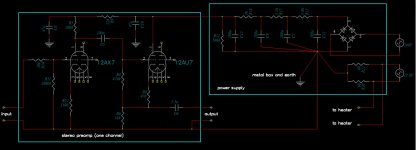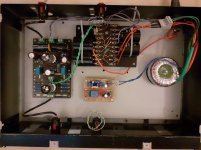Reasons for hum in valve stages.
1/ Hum from transformer too close to valve.
2/ Poor grounding. Use star grounding.
3/ Use screened cables for input signal.
4/ Power supply ground is mixed in with audio ground so charging currents into smoothing caps modulate audio ground.
5/ Hum pick up from AC into high impedance valve signals.
1/ Hum from transformer too close to valve.
2/ Poor grounding. Use star grounding.
3/ Use screened cables for input signal.
4/ Power supply ground is mixed in with audio ground so charging currents into smoothing caps modulate audio ground.
5/ Hum pick up from AC into high impedance valve signals.
I just thought of one other thing to try.
You said the circuit is quiet and works well at 60 volts B+, but becomes noisy and buzzy at 300 volts B+ using your DIY power supply.
Unfortunately, this doesn't tell us for sure that your 300V power supply is in fact the problem. The tube preamp will have a lot more voltage gain when you run it on 300 volts (compared to 60 volts), so the hum and buzz may simply be due to the increased voltage gain, and not due to any problems with the power supply.
That being the case, it might be worth trying out a different, cheap, 300 volts power supply: DC Boost Voltage Regulator, High Voltage DC-DC Boost Converter 8-32V 12V to +-45V-390V ZVS Capacitor Charging for Test Power Supply of Voltage or Glow Tube, Boost Converter Power Converter: Amazon.ca: Industrial & Scientific
If the preamp is quiet with this switch-mode power supply (adjusted to 300 volts DC), but noisy with your home-made 300 V power supply, then you know for sure that the problem is in your DIY power supply.
If the preamp buzzes equally with either 300 V power supply, you know the problem is *not* the power supply, but something else.
Using this little switch-mode power supply for B+ would also let you run both tube heaters, as well as B+, from one single regulated 12 volt DC power supply (wall wart).
Running AC power to tube heaters was the only practical option in 1930. But these days, we can get cheap, reliable switch-mode DC power supplies that produce clean, noise-free DC, and this is a much better way to power heaters in an audio tube.
-Gnobuddy
You said the circuit is quiet and works well at 60 volts B+, but becomes noisy and buzzy at 300 volts B+ using your DIY power supply.
Unfortunately, this doesn't tell us for sure that your 300V power supply is in fact the problem. The tube preamp will have a lot more voltage gain when you run it on 300 volts (compared to 60 volts), so the hum and buzz may simply be due to the increased voltage gain, and not due to any problems with the power supply.
That being the case, it might be worth trying out a different, cheap, 300 volts power supply: DC Boost Voltage Regulator, High Voltage DC-DC Boost Converter 8-32V 12V to +-45V-390V ZVS Capacitor Charging for Test Power Supply of Voltage or Glow Tube, Boost Converter Power Converter: Amazon.ca: Industrial & Scientific
If the preamp is quiet with this switch-mode power supply (adjusted to 300 volts DC), but noisy with your home-made 300 V power supply, then you know for sure that the problem is in your DIY power supply.
If the preamp buzzes equally with either 300 V power supply, you know the problem is *not* the power supply, but something else.
Using this little switch-mode power supply for B+ would also let you run both tube heaters, as well as B+, from one single regulated 12 volt DC power supply (wall wart).
Running AC power to tube heaters was the only practical option in 1930. But these days, we can get cheap, reliable switch-mode DC power supplies that produce clean, noise-free DC, and this is a much better way to power heaters in an audio tube.
-Gnobuddy
Running AC power to tube heaters was the only practical option in 1930. But these days, we can get cheap, reliable switch-mode DC power supplies that produce clean, noise-free DC, and this is a much better way to power heaters in an audio tube.
I have had hum problems numerous times with valve pre amps, mixers and power amps. In every case it wasn't the heaters being AC.
50/60Hz is pretty slow so shouldn't cause much if any pickup unless very careless with pcb/wiring routing.
Using AC heater transformer also limits power on current surge.
I disagree strongly (on the engineering suitability of AC heaters, not on any personal grounds.)nigelwright7557 said:50/60Hz is pretty slow so shouldn't cause much if any pickup unless very careless with pcb/wiring routing.
Running amperes of 50 or 60 Hz AC electric current through the guts of a sensitive audio amplifier - one with high input impedance at that - is one of the more horrid engineering compromises that I've ever encountered.
No sane audio engineer would ever think this was a good idea, unless he/she had been exposed to it since youth, and consequently had never actually thought about what a terrible "solution" it actually is.
Yes, you can do all sorts of shenanigans to minimize the negative impact of AC heater current, like twisting all heater wires tightly, and routing them very carefully. This is very much like carrying 50 pounds of rotting fish in the back seat of your car, but wrapping it in multiple layers of plastic to try and manage the stench.
A much better solution is to not carry rotting fish in your back seat. A much better solution is to not run large 50/60 Hz AC currents through your audio amplifier!
Decades ago, even after the arrival of silicon rectifier diodes, the AC heater power compromise was unavoidable. The only practical alternative at the time was to power heaters from batteries, and this came with a number of problems of its own, including cost, weight, bulk, and short lifetime. So I understand why engineers of the time chose to live with the rotting fish in the car.
All this changed completely when linear DC power supplies became largely obsolete, and switch-mode DC power supplies became the widely available, inexpensive standard. Nowadays it is actually cheaper, more compact, and lower-weight to use DC power to feed your heaters.
And the huge bonus is that you no longer need to run large audio-frequency noise currents (60 Hz AC) through the guts of your valve amplifier!
Throw out the stinking fish. Don't wrap it in layers of plastic and hope to control the smell.
A good heater transformer has a low source impedance, just like a good SMPS, so the benefits, if any, are minor. (And you have to live with the stinking fish in the back seat.)nigelwright7557 said:Using AC heater transformer also limits power on current surge
To reduce power-on current surge in the heaters while using a small SMPS to power them, there is a very, very simple solution, particularly since we cannot usually find 6.3V or 12.6V DC power supplies. The solution is to use a DC power supply with a slightly higher output voltage, and insert a suitable power resistor in series to drop the voltage to 6.3V when the heaters are at operating temperature.
The series resistor does double duty as a surge current limiter, reducing damaging turn-on currents in cold tube heaters.
There are more sophisticated solutions (such as designing the DC power supply to have CC/CV operation). But the simple series resistor lets us use dirt-cheap wall warts to power heaters. Most of us have several of these lying around the house doing nothing.
-Gnobuddy
I have noted your comments again. Thank you. it doesn't seem too difficult to apply them.
I have a DMM. I did some electrical voltage checks at each pin of the tubes. It's OK.
Now, I will implement your recommendations. I will also send you some pictures of my realization.
Ramon69
I have a DMM. I did some electrical voltage checks at each pin of the tubes. It's OK.
Now, I will implement your recommendations. I will also send you some pictures of my realization.
Ramon69
Good morning all. I'm not going to be original, but for this New Year, I wish everyone good health. The rest will follow ...
The bad weather and the confinement allowed me to do some electronics. I am coming back to you about my project. I have modified the construction of my preamp. Here is a photo and the diagram of the preamp. I always have a buzzz which is present at the output, even when the input is connected to ground. In this photo, the filaments are supplied with 12.6 V AC. I tried to supply them with 12.6 V DC but it didn't change anything. It is likely that several informations are missing to enable you to give an opinion, but I remain at your disposal to bring them to you.
Ramon
The bad weather and the confinement allowed me to do some electronics. I am coming back to you about my project. I have modified the construction of my preamp. Here is a photo and the diagram of the preamp. I always have a buzzz which is present at the output, even when the input is connected to ground. In this photo, the filaments are supplied with 12.6 V AC. I tried to supply them with 12.6 V DC but it didn't change anything. It is likely that several informations are missing to enable you to give an opinion, but I remain at your disposal to bring them to you.
Ramon
Attachments
That's it. It works !!!!!!!!!!!!!!!!!!!!!
It was laborious but it works very well. The preamp is silent like a sleeping kitten. It also works very well: very clear and dynamic.
A little later, I'll give a quick summary of the mistakes I made. It can be useful to someone.
Thank you all for your advice.
Ramon
It was laborious but it works very well. The preamp is silent like a sleeping kitten. It also works very well: very clear and dynamic.
A little later, I'll give a quick summary of the mistakes I made. It can be useful to someone.
Thank you all for your advice.
Ramon
- Status
- This old topic is closed. If you want to reopen this topic, contact a moderator using the "Report Post" button.
- Home
- Live Sound
- Instruments and Amps
- Modifying a 12ax7 HiFi valve preamp to be a guitar preamp

